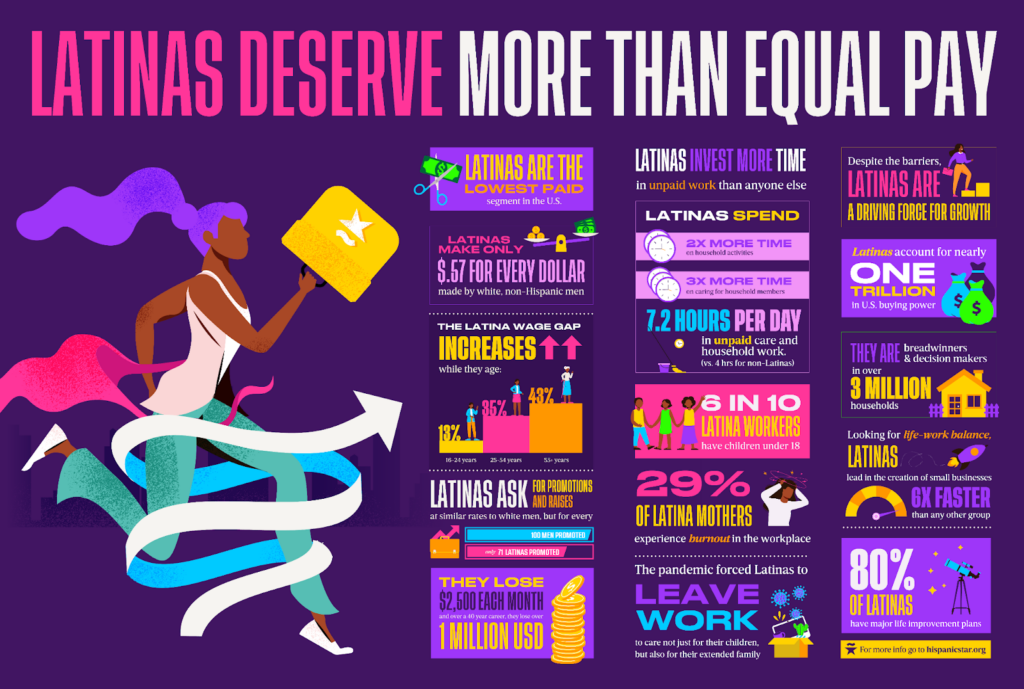
Women in our country face a significant pay gap, earning just 84 percent of what men earn. This number hasn’t budged in 15 years. If you’re a woman and want to earn what a man does, you better be prepared to work 42 extra days a year. If that’s not gobsmacking enough, consider Latinas, who earn just 55 percent of what white men earn, and that equates to an additional 293 days on the job to achieve parity.
I’m female. I’m Latina. I’m a tech CEO. It’s an understatement to say I’m a rare breed.
There are more than 60 million Hispanics in the U.S., according to the latest census data, making it the largest ethnic and racial minority. And while America is getting browner, the C-suite is not. In fact, there are just 16 Hispanic CEOs at S&P 500 companies—and not one is female.
Silicon Valley also has a particularly large diversity problem. Among the three largest tech companies, the percentage of Hispanic or Latinx employees working in technology positions, male or female, hovers between 5 and 8.5 percent of the total workforce. Fewer than half of these are female.
Apple, the largest tech company, reports that 8 percent of its U.S. tech workforce, both male and female, identify as Hispanic/Latinx according to its latest diversity and inclusion report. That number has stayed consistent since 2015. That’s right—despite an overall growing workforce, Hispanics/Latinx merely tread water.
Just 5.3 percent of Microsoft’s global tech workforce—again, both male and female—identify as Hispanic/Latinx, up from 4 percent in 2016. Lindsay-Rae McIntyre, Microsoft’s chief diversity officer, said in her precursor to Microsoft’s 2020 Diversity and Inclusion report, “We see clear opportunity to improve representation across all levels and roles, especially for Black and African American and Hispanic and Latinx employees.”
A disappointing 1.8 percent of Google’s tech workforce identifies as both female and Hispanic/Latinx, according to the Google 2021 Annual Diversity Report. If you’re looking for a small shred of progress, that number has doubled since 2015, when just 0.9 percent of Google’s tech workforce identified as female Hispanic/Latinx.

When I started my tech career, I was the only woman—the only Latina—at a 30-person tech company, and I would go into work, look around the room, and think, “This is just not right.” The lack of diversity not only negatively impacts the products and services we develop, but also the company culture, the rate of innovation, and the recruitment and retention of women and other underrepresented groups. I’ve climbed to the top to help others do the same.
Equal Pay Day was first observed in 1996 by the National Committee on Pay Equity in an effort to achieve pay equity for women of all backgrounds. The wage gap varies by demographic, with Asian American women faring slightly better than women in general, as pay typically equals men in March, just ahead of the national observance. Black Equal Pay Day typically falls in August, Native American Equal Pay Day in September, and then, last come Latinas in October.
As we mark the day this year, here’s what to do to make sure you’re getting paid equally. Although my work is primarily in tech, the gender wage gap transcends industries and the following are recommended for women in every industry.
1. Know your worth.
Searches on career sites like www.Glassdoor.com can return a wealth of information on salaries by industry, level, geography and more.
Also, trusted colleagues and mentors who are familiar with the industry often have insights here, so tap your network.
Finally, factor in your own professional experience and accomplishments. This will help you determine your worth. Don’t be afraid to aim high. Women tend to be less bold in their salary requests, and that holds us back. Remember that you score none of the shots you don’t take.
2. Research the organization.
Third parties like the Fair Pay Workforce certify that organizations are committed to pay equity. To qualify, companies must undergo a rigorous evaluation of their data and practices via a transparent set of rules and standards and commit to following a tailored plan building upon their fair pay practices. Look for symbols like the one from Fair Pay Workforce and other similar organizations.
Independent research, too, can reveal loads about an organization. For example, take a look at a company’s board composition. Is the board comprised of men and women equally? Does it include those from marginalized communities, including BIPOC, LGBTQIA, and differently-abled executives? The more diverse a board is, the more likely the organization is committed to a fair and equitable workplace, including pay.
3. Know the law.
The Equal Pay Act that passed in 1963 requires men and women in the same workplace be given equal pay for equal work. Job content (not job titles) determines whether jobs are substantially equal. All forms of pay are covered by this law, including salary, overtime pay, bonuses, stock options, profit sharing and bonus plans, life insurance, vacation and holiday pay, cleaning or gasoline allowances, hotel accommodations, reimbursement for travel expenses, and benefits.
If there is an inequality in wages between men and women, employers may not reduce the wages of either sex to equalize their pay. If you feel you are being undercompensated compared to male counterparts, meet with HR to discuss the concern and remember to document the conversation, which will be useful if the situation elevates to a legal level.
4. Get involved politically.
Congress passed the Paycheck Fairness Act earlier this year. This bill addresses wage discrimination on the basis of sex, which is defined to include pregnancy, sexual orientation, gender identity and sex characteristics. Specifically, it limits an employer’s defense that a pay differential is based on a factor other than sex, to only bona fide job-related factors in wage discrimination claims, enhances non-retaliation prohibitions, and makes it unlawful to require an employee to sign a contract or waiver prohibiting the employee from disclosing information about the employee’s wages. The bill also increases civil penalties for violations of equal pay provisions.
Educate yourself on local and national candidates. In this age of misinformation, make sure you get insights from trusted sources like local newspapers, or websites like Ballotpedia, which is a digital encyclopedia for American politics and elections. Voting is one of the most powerful tools we have to fight systemic discrimination to build a better future for our daughters.
Don’t stop fighting until you’re equal. You are worth it. And I’ll say it again for those in the back, No dejes de luchar hasta que seas igual. Tu lo vales.
Up next:





